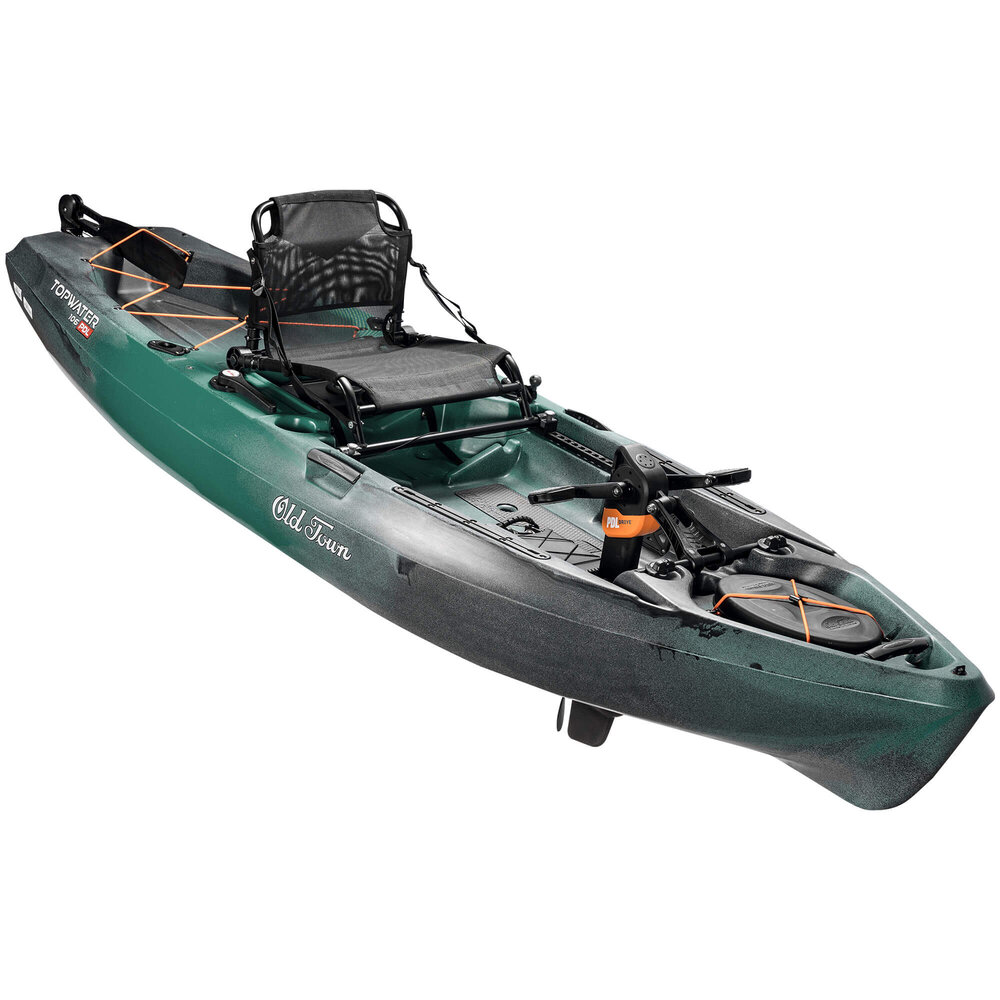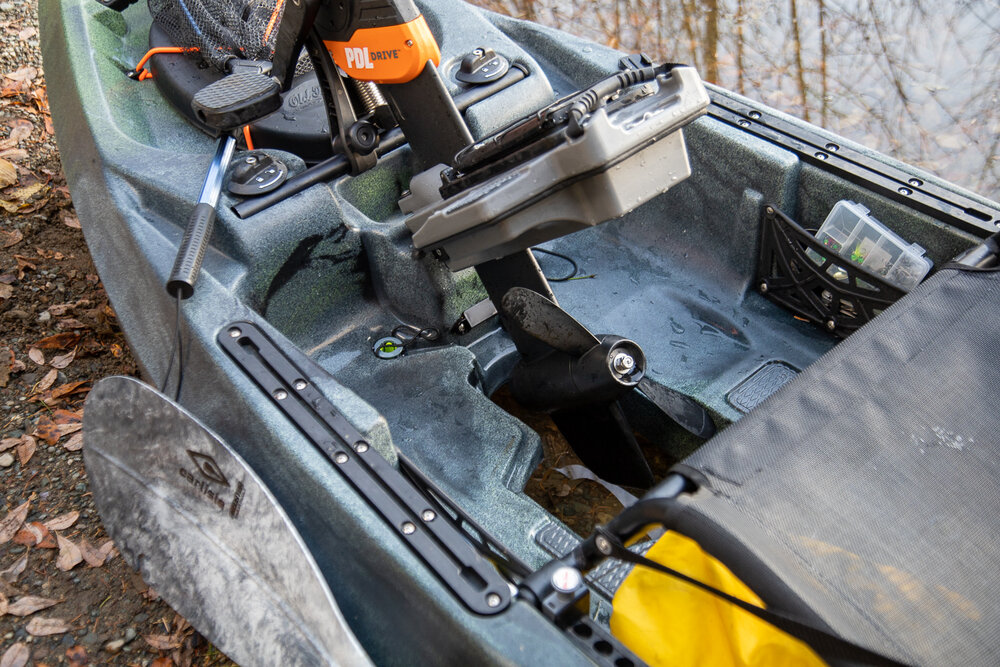I remember the first time seeing a pedal-powered kayak and thinking, “That’s odd. Why would anyone want to do that?”
And now I can’t get enough of using the pedals. I’m addicted.
It’s not like I haven’t given the paddle a fair chance. I have a 16 foot Necky in the garage with a good old Werner paddle. I’ve used it a lot but it just requires, you know, paddling.
Old Town knows their canoes and kayaks. They’ve been making them since 1868. The pedal powered versions are a more recent product and a welcome addition.
The Topwater PDL 106 kayak is a 10’6” sit-on-top kayak with a pedal drive aimed at fishing but can be used for any kind of flat water kayaking.
First some of the specs and then we’ll get into what drives this thing. (Check the price at REI.)
Specs
- 10’6” long, 36” wide
- PDL pedal drive
- Stable DoubleU hull
- Single Layer Polyethylene construction
- ElementAir seat
- 2 rod holders
- Universal transducer mounting system
- EVA foam deck pads
- Bow and seat hatches
- 45 kg (100 pounds)
- 204 kg (450 pound) capacity (including the boat)
- $1,999 US

Pedal power
The star of the show is the PDL drive that you pedal with your feet. 2 pedals drive a propeller under the boat with the rudder for steering. It’s easy to pedal forwards to go forwards and backwards to go backwards.
The PDL drive is removable for transport and can swing up into the boat if you’re shallow water. This does mean there’s a big open hole in your boat if the prop is up. The inside of the boat is sealed and extremely bouyant but you can end up with a little water in the bottom of the boat if you launch with the prop up. You can stay dry by launching from a dock with the prop down the whole time.
It’s helpful to swing the prop up when you launch but also when you’re in very shallow streams or tidal areas. The depth of the boat to the bottom of the prop is about 16”. A nice spot to paddle not far from my house passes in between 2 islands and at low tide it can be dry. I’ve padded through with 6 inches of water with the prop up. Even hopped in to grab a crab to cook up on the beach!
A small dry storage in the base of the drive is a great place to store keys, wallet and phones. It’s big enough to hold small tackle boxes as well. The air in it also doubles as a life preserver for the drive if it happens to go overboard. 2 clamps hold the drive bar in place so unless, you’ve got it completely removed, it’ll never fall off.
While you’re pedaling for propulsion, steering is done with the rudder and a small knob to the left of the chair. The drive doesn’t turn itself, so you have to be moving to steer. A lever to the right of the chair moves the rudder in and out of the water. Don’t forget to pull up your rudder when you hit shore!
One benefit of the pedal drive is that pedaling uses your leg muscles which can go for much longer than your arms can. I find I can putter along at a steady pace with my legs much easier than paddling.
The other benefit is that your hands are free to fish, take photos or drink your coffee. Your legs are doing all the work.
Something to note and really comes down to personal preference is the pedals go around in a circle like bike pedals. Other pedal drives like the Hobie Mirage drives, are pushed forward and back.
Stable, DoubleU hull
The PDL 106 is 10’6” long and 36” wide. Double U shape to the hull and the 36” width makes it extremely stable. It’s easy to stand and fish or get something out of storage behind the seat.
I spend a lot of time on stand up paddleboards that are as wide or wider than this board but still find I have to mind my balance while standing and moving around. I don’t even have to think about it on the Topwater. It’s like standing on a dock.
I’ve had 2 kids on the boat with me and even with them moving around, hardly had to think about stability. It would take a very concerted effort to flip it.
The only downside to the DoubleU shape of the hull is most kayak carts don’t work well with it. I have a Pelican folding cart with large wheels and the frame of it fits right into the indent of the hull putting the wheels on the hull. With the wheels on the hull, they ain’t spinning at all when you pull the boat. I’ve added enough a few inches of padding to the cart so the frame holds the boat without touching the tires. Another option would be to extend the frame so it holds the ‘pontoons’ of either side of the boat and keeps it off the tires.








Very durable
The rotomolded polyethylene the Topwater is made from is extremely durable. I try to use the kayak cart as much as possible but if I forgotten it or decided not to bring it, I’ve had to drag it on rocks and barnacles. It scrapes the bottom a bit but the plastic is so thick, I don’t even worry about it. Hitting a rock or log while pedalling doesn’t even scratch it.
Hitting the prop is another story. It’s a sturdy setup with the leg of the prop protecting the prop for the most part. The leg extend down to the bottom of the prop as well. If a large object were to catch the prop while it was spinning you may have some issues. I try to be careful when I’m in shallower water or see anything submerged.
Fishing
The Topwater is a fishing machine. It’s been built to hunt those keepers through any conditions and water.
2 rod holders right behind the seat are easy to access and hold most rods. Track mounts in front of both sides of the seat can mount RAM or Scotty track mounts and hold 2 or 3 mounts each.
A transducer mount is tucked up into the keep in front of the PDL drive. It’s set into the hull a bit so it’s out of way when you pull up to shore or hit something hallow.
Storage behind the seat is a perfect size for fishing crates with an included bungee to secure the whole deal.
My early version of the PDL included a handle to one side of the rudder but later versions have the handles under the stern which would make it easier to balance while carrying. This allows for space for an anchor mount to to the left of the rudder as well.
The EVA foam pads where you stand are comfortable and grippy. The seat can slide back easily so you have tons of room for standing and casting. And, as I mentioned above, the whole thing is ridiculously stable so you can focus on fishing and not staying upright.
Seat
The ElementAir seat is covered with a thin mesh and is quite comfortable. The mesh is a bit loose on mine so I can feel the back bar of the seat at the bottom. Not a deal breaker but would be better if the mesh was a touch tighter. There is a velcro adjustment to make it looser or tighter but even with it on the tightest setting I can still feel it a bit. I will be adding a bit of padding there for the longer days paddling.
When you’ve hit shore for lunch the seat can be taken off and put on the ground. The back of the seat is right on the ground though so it needs to be something comfortable and dry to sit on. It would be nice for the seat to be raised a little at the back or have legs to flip out so you can use it on the beach better.
I have my seat at the closest setting it can go to the pedals. I’m 5’7” and have a 30 inch inseam so I wouldn’t recommend using with shorter legs that that. There’s about 12-14 inches adjustment longer than that so there’s plenty of room for people with longer legs.

Storage
For being only 10’6” long the Topwater has a good amount of storage.
A drink holder beside the seat and 2 small side pockets beside the footpads.
The rear area behind the seat has bungees over plenty of room for waterproof duffels or fishing crates. Getting to the gear in the back isn’t too bad in calm water, the seat can fold down and you have full access to your gear back there.
A large hatch in the bow can hold 2 or 3 dry bags worth of gear. Storage runs down both sides of the boat so longer rods can fit inside as long as there’s nothing blocking the hatch. A smaller hatch opening right behind the seat gets access to the same area inside the boat.
One of the issues with small items in the boat is they can go missing if they’re contained within a larger container or dry bag. I lost a whole Helinox Chair Zero in the hull for a couple months and just recently found it. Some hanging organizers for these spaces would be very nice.
A small compartment in the PDL drive right in between the footpads can hold a phone, wallet and small tackle box with no issues. It’s watertight as well in case some splashes come over the side.
Other versions
There are multiple other versions to the Topwater. There is the regular non pedal version, a 120 (12 feet long) and a Sportsman PDL 106. The Sportsman has better handles on the stern and an upgraded seat.
Conclusion
I’ve spent many days on the water with the Topwater PDL 106 fishing, exploring, and hauling gear around to go freediving. I’ve dragged it over rocky beaches, shoved it up onto the top rack of my SUV and loaded it up with multiple people.
For a roto-molded pedal drive kayak, I highly recommend it. There are lighter types of boats out there which are inflatable (and have their own downsides). The weight can be an issue if you’re trying to put it on the top of your car but if you have 2 people paddling or a wheeled kayak cart then it’s not really a problem.
I really like the durability of the Topwater and not having to worry about the bottom of the boat. While you do have to pay attention to what you’re paddling around because of the propeller, I’ve still run into numerous sticks and logs and the keel has protected it so far.
By far the best part is the pedal drive and being able to pedal for hours, hands free anywhere you need to go. I makes fishing and taking photos easier. Cruising longer distances is easier with the bigger muscles in your legs compared to your arms.
Definitely give the Topwater PDL 106 a try if you can.
What Kind of distances would you be comfortable traveling in this one?
Hey Darrin,
I tend to go 2 or 3 km/h and will spend 3 or 4 hours paddling at a time. It’s a leg workout going faster or farther but totally doable if your legs are up for it.